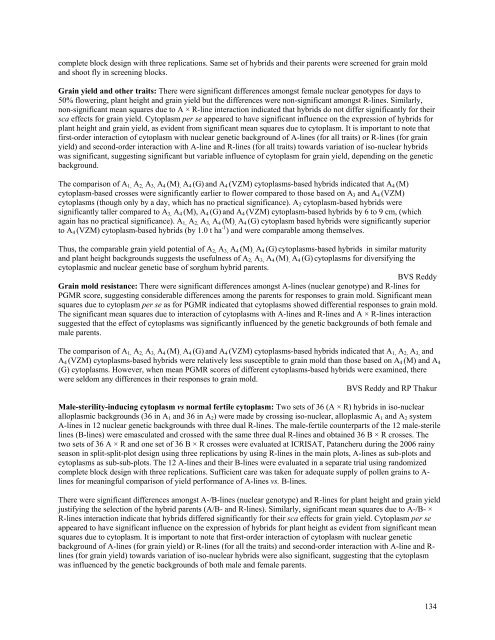ICRISAT Archival Report 2006 - The seedlings of success in the ...
ICRISAT Archival Report 2006 - The seedlings of success in the ...
ICRISAT Archival Report 2006 - The seedlings of success in the ...
You also want an ePaper? Increase the reach of your titles
YUMPU automatically turns print PDFs into web optimized ePapers that Google loves.
complete block design with three replications. Same set <strong>of</strong> hybrids and <strong>the</strong>ir parents were screened for gra<strong>in</strong> mold<br />
and shoot fly <strong>in</strong> screen<strong>in</strong>g blocks.<br />
Gra<strong>in</strong> yield and o<strong>the</strong>r traits: <strong>The</strong>re were significant differences amongst female nuclear genotypes for days to<br />
50% flower<strong>in</strong>g, plant height and gra<strong>in</strong> yield but <strong>the</strong> differences were non-significant amongst R-l<strong>in</strong>es. Similarly,<br />
non-significant mean squares due to A × R-l<strong>in</strong>e <strong>in</strong>teraction <strong>in</strong>dicated that hybrids do not differ significantly for <strong>the</strong>ir<br />
sca effects for gra<strong>in</strong> yield. Cytoplasm per se appeared to have significant <strong>in</strong>fluence on <strong>the</strong> expression <strong>of</strong> hybrids for<br />
plant height and gra<strong>in</strong> yield, as evident from significant mean squares due to cytoplasm. It is important to note that<br />
first-order <strong>in</strong>teraction <strong>of</strong> cytoplasm with nuclear genetic background <strong>of</strong> A-l<strong>in</strong>es (for all traits) or R-l<strong>in</strong>es (for gra<strong>in</strong><br />
yield) and second-order <strong>in</strong>teraction with A-l<strong>in</strong>e and R-l<strong>in</strong>es (for all traits) towards variation <strong>of</strong> iso-nuclear hybrids<br />
was significant, suggest<strong>in</strong>g significant but variable <strong>in</strong>fluence <strong>of</strong> cytoplasm for gra<strong>in</strong> yield, depend<strong>in</strong>g on <strong>the</strong> genetic<br />
background.<br />
<strong>The</strong> comparison <strong>of</strong> A 1, A 2, A 3, A 4 (M) , A 4 (G) and A 4 (VZM) cytoplasms-based hybrids <strong>in</strong>dicated that A 4 (M)<br />
cytoplasm-based crosses were significantly earlier to flower compared to those based on A 3 and A 4 (VZM)<br />
cytoplasms (though only by a day, which has no practical significance). A 2 cytoplasm-based hybrids were<br />
significantly taller compared to A 3, A 4 (M), A 4 (G) and A 4 (VZM) cytoplasm-based hybrids by 6 to 9 cm, (which<br />
aga<strong>in</strong> has no practical significance). A 1, A 2, A 3, A 4 (M) , A 4 (G) cytoplasm based hybrids were significantly superior<br />
to A 4 (VZM) cytoplasm-based hybrids (by 1.0 t ha -1 ) and were comparable among <strong>the</strong>mselves.<br />
Thus, <strong>the</strong> comparable gra<strong>in</strong> yield potential <strong>of</strong> A 2, A 3, A 4 (M) , A 4 (G) cytoplasms-based hybrids <strong>in</strong> similar maturity<br />
and plant height backgrounds suggests <strong>the</strong> usefulness <strong>of</strong> A 2, A 3, A 4 (M) , A 4 (G) cytoplasms for diversify<strong>in</strong>g <strong>the</strong><br />
cytoplasmic and nuclear genetic base <strong>of</strong> sorghum hybrid parents.<br />
BVS Reddy<br />
Gra<strong>in</strong> mold resistance: <strong>The</strong>re were significant differences amongst A-l<strong>in</strong>es (nuclear genotype) and R-l<strong>in</strong>es for<br />
PGMR score, suggest<strong>in</strong>g considerable differences among <strong>the</strong> parents for responses to gra<strong>in</strong> mold. Significant mean<br />
squares due to cytoplasm per se as for PGMR <strong>in</strong>dicated that cytoplasms showed differential responses to gra<strong>in</strong> mold.<br />
<strong>The</strong> significant mean squares due to <strong>in</strong>teraction <strong>of</strong> cytoplasms with A-l<strong>in</strong>es and R-l<strong>in</strong>es and A × R-l<strong>in</strong>es <strong>in</strong>teraction<br />
suggested that <strong>the</strong> effect <strong>of</strong> cytoplasms was significantly <strong>in</strong>fluenced by <strong>the</strong> genetic backgrounds <strong>of</strong> both female and<br />
male parents.<br />
<strong>The</strong> comparison <strong>of</strong> A 1, A 2, A 3, A 4 (M) , A 4 (G) and A 4 (VZM) cytoplasms-based hybrids <strong>in</strong>dicated that A 1, A 2, A 3, and<br />
A 4 (VZM) cytoplasms-based hybrids were relatively less susceptible to gra<strong>in</strong> mold than those based on A 4 (M) and A 4<br />
(G) cytoplasms. However, when mean PGMR scores <strong>of</strong> different cytoplasms-based hybrids were exam<strong>in</strong>ed, <strong>the</strong>re<br />
were seldom any differences <strong>in</strong> <strong>the</strong>ir responses to gra<strong>in</strong> mold.<br />
BVS Reddy and RP Thakur<br />
Male-sterility-<strong>in</strong>duc<strong>in</strong>g cytoplasm vs normal fertile cytoplasm: Two sets <strong>of</strong> 36 (A × R) hybrids <strong>in</strong> iso-nuclear<br />
alloplasmic backgrounds (36 <strong>in</strong> A 1 and 36 <strong>in</strong> A 2 ) were made by cross<strong>in</strong>g iso-nuclear, alloplasmic A 1 and A 2 system<br />
A-l<strong>in</strong>es <strong>in</strong> 12 nuclear genetic backgrounds with three dual R-l<strong>in</strong>es. <strong>The</strong> male-fertile counterparts <strong>of</strong> <strong>the</strong> 12 male-sterile<br />
l<strong>in</strong>es (B-l<strong>in</strong>es) were emasculated and crossed with <strong>the</strong> same three dual R-l<strong>in</strong>es and obta<strong>in</strong>ed 36 B × R crosses. <strong>The</strong><br />
two sets <strong>of</strong> 36 A × R and one set <strong>of</strong> 36 B × R crosses were evaluated at <strong>ICRISAT</strong>, Patancheru dur<strong>in</strong>g <strong>the</strong> <strong>2006</strong> ra<strong>in</strong>y<br />
season <strong>in</strong> split-split-plot design us<strong>in</strong>g three replications by us<strong>in</strong>g R-l<strong>in</strong>es <strong>in</strong> <strong>the</strong> ma<strong>in</strong> plots, A-l<strong>in</strong>es as sub-plots and<br />
cytoplasms as sub-sub-plots. <strong>The</strong> 12 A-l<strong>in</strong>es and <strong>the</strong>ir B-l<strong>in</strong>es were evaluated <strong>in</strong> a separate trial us<strong>in</strong>g randomized<br />
complete block design with three replications. Sufficient care was taken for adequate supply <strong>of</strong> pollen gra<strong>in</strong>s to A-<br />
l<strong>in</strong>es for mean<strong>in</strong>gful comparison <strong>of</strong> yield performance <strong>of</strong> A-l<strong>in</strong>es vs. B-l<strong>in</strong>es.<br />
<strong>The</strong>re were significant differences amongst A-/B-l<strong>in</strong>es (nuclear genotype) and R-l<strong>in</strong>es for plant height and gra<strong>in</strong> yield<br />
justify<strong>in</strong>g <strong>the</strong> selection <strong>of</strong> <strong>the</strong> hybrid parents (A/B- and R-l<strong>in</strong>es). Similarly, significant mean squares due to A-/B- ×<br />
R-l<strong>in</strong>es <strong>in</strong>teraction <strong>in</strong>dicate that hybrids differed significantly for <strong>the</strong>ir sca effects for gra<strong>in</strong> yield. Cytoplasm per se<br />
appeared to have significant <strong>in</strong>fluence on <strong>the</strong> expression <strong>of</strong> hybrids for plant height as evident from significant mean<br />
squares due to cytoplasm. It is important to note that first-order <strong>in</strong>teraction <strong>of</strong> cytoplasm with nuclear genetic<br />
background <strong>of</strong> A-l<strong>in</strong>es (for gra<strong>in</strong> yield) or R-l<strong>in</strong>es (for all <strong>the</strong> traits) and second-order <strong>in</strong>teraction with A-l<strong>in</strong>e and R-<br />
l<strong>in</strong>es (for gra<strong>in</strong> yield) towards variation <strong>of</strong> iso-nuclear hybrids were also significant, suggest<strong>in</strong>g that <strong>the</strong> cytoplasm<br />
was <strong>in</strong>fluenced by <strong>the</strong> genetic backgrounds <strong>of</strong> both male and female parents.<br />
134

















